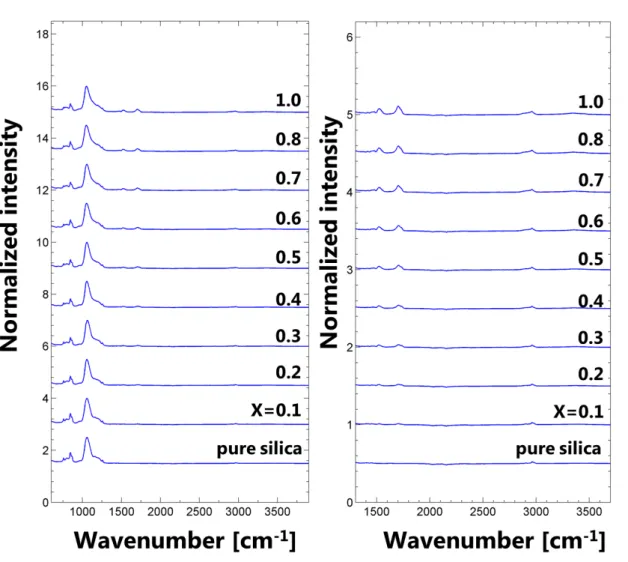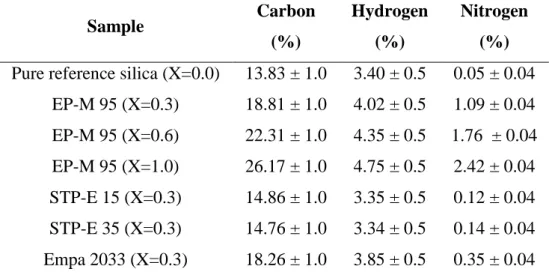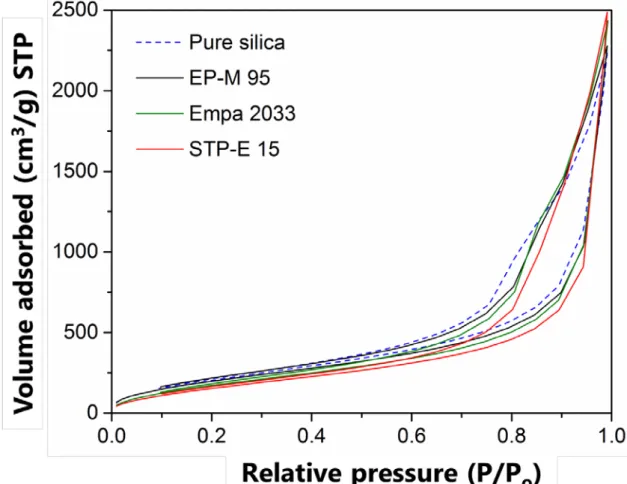1
Supplementary Information
Reinforced and superinsulating silica aerogel through in situ cross-linking with silane terminated prepolymers
Subramaniam Iswar, Geert M. B. F. Snellings, Shanyu Zhao, Rolf Erni, Yeon Kyoung Bahk, Jing Wang, Marco Lattuada, Matthias M. Koebel and Wim J. Malfait
2
Table of contents
1. Preparation and characterization of prepolymers from natural oil based polyols 3
2. Thermal conductivity setup 5
3. Particle release by the mechanical impact setup 5
4. Digital photos 6
5. Density and thermal conductivity 9
6. NMR Spectroscopy 10
7. FTIR Spectroscopy 11
8. Elemental analysis 13
9. Scanning and Transmission electron microscopy analysis 14
10. Nitrogen adsorption-desorption characterization 15
11. Uniaxial compression test 16
12. Particle release results 19
13. Thermogravimetric analysis 21
14. Humidity uptake 22
15. Water contact angle 24
16. Summary of different properties of hybrid aerogels 26
3
1. Preparation and characterization of prepolymers from natural oil based polyols
Five silane terminated prepolymers, namely Empa 1990, Empa 2033, Empa D-140, Empa D-265 and Empa D-290, were synthesized by using Natural Oil based Polyols (NOPs) namely Radianol 1990 (Oleon), PripolTM 2033 (Croda), Polycin® D-140, Polycin® D-265 and Polycin® D-290 (Vertellus®) respectively. Following is the general experimental procedure:
• Start with a calculated amount of the respective polyol in a beaker at room temperature.
• Add catalyst (Fomrez® UL-28) dropwise under continuous stirring.
• In a next step, add the calculated amount of 3-(triethoxysilyl) propyl isocyanate (Sigma-Aldrich) dropwise via a separation funnel under continuous stirring.
• Temperature is monitored during the reaction to determine the exotherm. • No solvent is used during the reaction.
After the prepolymers were synthesized, they were characterized by solution 1H NMR. For all prepolymers from the various NOPs, the reaction is complete as evidenced by the disappearance of e band and the appearance of f’ and e’ bands (Figure S1). The peak intensity ratio f’, b’ and e’ is very close to 2-6-2 protons for all samples, indicating there is exactly one urethane bond per silane group as expected.
4
Figure S1. 1H NMR of five silane terminated prepolymers namely Empa 1990, Empa 2033, Empa D-140, Empa D-265 and Empa D-290 synthesized by using Natural Oil based Polyols (NOPs).
5 2. Thermal conductivity setup
Figure S2. Custom built guarded hot plate device for thermal conductivity measurement[1].
3. Particle release by the mechanical impact setup
Figure S3. Experimental setup for the particle release from aerogels by the mechanical
6 4. Digital photos
Figure S4. Digital photos of pure reference silica and EP-M 95 hybrid aerogels for different
7
Figure S5. Digital photos of pure reference silica and NOP based hybrid aerogels for X=0.3
(prepolymer (X):SiO2).
Figure S6. Digital photos of pure reference silica and Empa 2033 hybrid aerogels for
8
Figure S7. Digital photos of (a) STP-E 15 and (b) STP-E 35 hybrid aerogels for different
concentrations (prepolymer (X):SiO2).
a)
9 5. Density and thermal conductivity
Figure S8. Thermal conductivity as a function of density of hybrid aerogels using different
10
6. NMR Spectroscopy
Figure S9. (a) 1H-13Ccross polarization (CP) and (b) Quantitative 1H solid–state MAS NMR spectra of EP-M 95 hybrid aerogels for increasing concentrations.
a)
11 7. FTIR Spectroscopy
Figure S10. ATR-FTIR spectra of pure reference silica and EP-M 95 hybrid aerogels for
increasing concentrations.
ATR-FTIR spectra of EP-M 95 hybrid aerogels display changes with increasing concentrations when compared to pure reference silica aerogel, with an increase in the broad bands near 2960 cm-1 related to the C-H stretching vibration and the increasing intensity of C-N, N-H stretching bands near 1520 cm-1 and C=O bands near 1700 cm-1 respectively[2,3] (Figure S10). The increasing intensities of these bands confirm the systematic incorporation of the prepolymer into the aerogel matrix.
12
The higher variability in the prepolymer peak intensities for the X=1.0 sample, compared to those with lower prepolymer concentrations, is indicative of an inhomogeneity in the prepolymer distribution (Figure S11).
Figure S11. (a) ATR-FTIR spectra; Maximum peak intensities at (b) 1520 cm-1 and (c) 1700 cm-1 of EP-M 95 hybrid aerogels for increasing concentrations. The numbers indicate the standard deviation from 21 measurements.
13 8. Elemental analysis
Table S1: Elemental analysis of pure reference silica and hybrid aerogels.
Sample Carbon (%) Hydrogen (%) Nitrogen (%)
Pure reference silica (X=0.0) 13.83 ± 1.0 3.40 ± 0.5 0.05 ± 0.04 EP-M 95 (X=0.3) 18.81 ± 1.0 4.02 ± 0.5 1.09 ± 0.04 EP-M 95 (X=0.6) 22.31 ± 1.0 4.35 ± 0.5 1.76 ± 0.04 EP-M 95 (X=1.0) 26.17 ± 1.0 4.75 ± 0.5 2.42 ± 0.04 STP-E 15 (X=0.3) 14.86 ± 1.0 3.35 ± 0.5 0.12 ± 0.04 STP-E 35 (X=0.3) 14.76 ± 1.0 3.34 ± 0.5 0.14 ± 0.04 Empa 2033 (X=0.3) 18.26 ± 1.0 3.85 ± 0.5 0.35 ± 0.04 The uncertainties correspond to one standard deviation from 3 repeat measurements.
14
9. Scanning and transmission electron microscopy analysis
Figure S12. SEM images of EP-M 95 hybrid aerogel for X=1.0 concentration.
Figure S13. TEM images of EP-M 95 hybrid aerogel for X=1.0 concentration.
There are inhomogenity in the microstructure for EP-M 95 hybrid aerogel at X=1.0 concentration as depicted in the SEM and TEM images due to the presence of silica rich and polymer rich domains (Figs. S12 and S13).
Silica rich domain polymer rich domain polymer rich domain Silica rich domain polymer rich
15
10. Nitrogen adsorption-desorption characterization
Figure S14. Nitrogen sorption isotherms of pure reference silica aerogel and EP-M 95,
16
11. Uniaxial compression test
Figure S15. Compressive stress-strain curves of pure reference silica and hybrid aerogels
from different prepolymers for X=0.3 concentration; a for X=0.25 (X:SiO2).
Figure S16. Compressive stress-strain curves of Empa 2033 hybrid aerogels for increasing
17
Figure S17. (a) Compressive modulus (E), (b) Compressive strength at 10% strain (σ10), (c)
Compressive strength at 50% strain (σ50) and (d) Final compressive strength (σmax) of EP-M
95 hybrid aerogels for increasing concentrations.
Figure S18. (a) Compressive modulus (E), (b) Compressive strength at 10% strain (σ10), (c)
Compressive strength at 50% strain (σ50) and (d) Final compressive strength (σmax) of Empa
18
Figure S19. Log (Emodulus) vs Log (bulk density) for different aerogel like materials[4–16].
Table S2: Slopes of Log (Emodulus) vs Log (bulk density) for different aerogel like materials[4–16] Samples Slope Aeropectin 2.38 Aerocellulose 2.88 NFC foams 1.90 Cellulose-silica hybrids 3.24 PU aerogels 3.62 PU-silica hybrids 3.70 Pectin-silica hybrids 3.85 Pure reference silica 3.91 EP-M 95-silica hybrids 3.17
19 12. Particle release results
Figure S20. Particle release at 100 rpm for (a) SMPS (10-500 nm), (b) APS (0.54-19.8 μm)
and at 300 rpm for (c) SMPS (10-500 nm), (d) APS (0.54-19.8 μm) of EP-M 95 hybrid aerogels for different concentrations.
Figure S21. Average particle concentration of EP-M 95 hybrid aerogels measured for 1
hour at different concentrations for SMPS (10-500 nm) and APS (0.54-19.8 μm) respectively.
20
When compared to pure reference silica aerogel, the average particle concentration went down significantly for the EP-M 95 hybrid aerogels with increasing concentrations. Mechanically strong hybrid aerogels reduced the particle release (SMPS (10-500 nm), APS (0.54-19.8 μm)) observed for both mild (100 rpm) and extreme mechanical impact conditions (300 rpm) (Figs. S20a-d and S21). The increase in the particle release for the hybrid aerogels at 1.0 concentration can be related to the inhomogeneity in the microstructure due to the silica rich and polymer rich domains as observed in the SEM, TEM and water contact angle analysis (Figs. S12, S13 and S27) and the variations in the surface inhomogeneity as indicated by the ATR-FTIR analysis (Figure S11).
21 13. Differential thermogravimetric analysis
Figure S22. TGA curves (in 80% v/v oxygen and 20% v/v nitrogen) of pure reference silica
aerogel (X=0.0) and EP-M 95 hybrid aerogels for different concentrations.
Figure S22 shows the thermogravimetric analysis (TGA) of pure reference silica aerogel (X=0.0) and EP-M 95 hybrid aerogels for different concentrations in the temperature range of 30-900°C in air at a heating rate of 5°C/min. For all samples, there is minimal weight loss of about 1% up to 200°C. Pure reference silica aerogel starts to decompose at 274°C due to the loss of trimethylsilyl (TMS) groups present on the silica aerogel backbone as reported in the literature[17,18]. They show the lowest weight loss of 11.8% compared to the EP-M 95 hybrid aerogels. On the other hand, the hybrid aerogels (with increasing concentrations) start to decompose between 245-262°C with a weight loss between 22 to 36%. Hence, an operating temperature above 240°C is not recommended for the EP-M 95 hybrid aerogels.
22 14. Humidity uptake
Figure S23. Humidity uptake of pure reference silica and EP-M 95 hybrid aerogels as a
function of relative humidity for different concentrations.
Figure S24. Humidity uptake of Natural Oil based Polyol (NOP) based hybrid aerogels as a
23
Figure S25. Humidity uptake of pure reference silica and STP-E 15 hybrid aerogels as a
function of relative humidity for different concentrations.
Figure S26. Humidity uptake of pure reference silica and STP-E 35 hybrid aerogels as a
24 15. Water contact angle
Figure S27. Water contact angles of EP-M 95 hybrid aerogels for increasing concentrations.
Figure S28. Water contact angles of Natural Oil based Polyol (NOP) based hybrid aerogels
25
Figure S29. Water contact angles of STP-E 15 hybrid aerogels for increasing
concentrations.
Figure S30. Water contact angles of STP-E 35 hybrid aerogels for increasing
26 16. Summary of different properties of hybrid aerogels
Table S3: Summary of different properties of hybrid aerogels.
Sample Prepolymer (X):SiO2 ρbulka) (g/cm3) ρskeletalb) (g/cm3) SBETc) (m2/g) Vpore, BJH (cm3/g) Vpored) (cm3/g) Dpore, BJH (nm) Dporee) (nm) λf) (mW·m-1·K-1) Emod (MPa) σ10 (MPa) σ50 (MPa) σmax (MPa) Strain at σmax (%) avg. WCA (°) Linear shrinkage (%) Reference silica 0.0 0.087 1.56 850 3.5 10.9 12.6 51.1 16.5 0.90 0.071 - 0.3 42 138 8 EP-M 95 0.1 0.100 - - - 15.4 0.68 0.059 0.406 2.4 80 146 10 EP-M 95 0.2 0.107 - - - 15.1 0.59 0.052 0.425 5.2 80 148 10 EP-M 95 0.25 0.104 - - - 15.3 0.61 0.053 0.396 4.1 80 - 10 EP-M 95 0.3 0.106 1.43 791 3.5 8.7 13.7 44.2 14.7 0.78 0.059 0.478 6.4 80 147 10 EP-M 95 0.4 0.119 - - - 14.8 0.91 0.072 0.593 8.4 80 148 12 EP-M 95 0.5 0.125 - - - 15.0 - - - 141 14 EP-M 95 0.6 0.139 1.34 673 3.6 6.4 17.6 38.3 15.0 1.55 0.100 0.867 12.2 80 146 14 EP-M 95 0.7 0.145 - - - 15.2 2.00 0.132 1.090 14.7 80 136 14 EP-M 95 0.8 0.154 - - - 15.8 2.77 0.202 1.547 19.2 80 140 16 EP-M 95 1.0 0.179 1.32 650 3.8 4.8 20.5 29.7 16.8 3.37 0.251 1.916 20.5 80 122 18 STP-E 15 0.1 0.089 - - - 17.1 - - - 139 8 STP-E 15 0.2 0.100 - - - 17.2 - - - 130 10 STP-E 15 0.25 0.126 - - - 17.0 0.80 0.063 0.387 4.9 80 - 10 STP-E 15 0.3 0.117 - 666 3.8 - 16.6 - 17.3 - 100 12 STP-E 15 0.4 0.149 - - - 17.8 - - - 115 18 STP-E 15 0.5 0.213 - - - 20.9 - - - 122 24 STP-E 35 0.1 0.094 - - - 16.4 - - - 132 8 STP-E 35 0.2 0.102 - - - 16.8 - - - 135 10 STP-E 35 0.25 0.116 - - - 16.6 0.87 0.073 0.486 6.2 80 - 10 STP-E 35 0.3 0.119 - - - 17.4 - - - 113 12 STP-E 35 0.4 0.144 - - - 17.8 - - - 119 16 Empa 2033 0.1 0.102 - - - 16.5 - - - 10 Empa 2033 0.2 0.103 - - - 15.8 - - - 10 Empa 2033 0.3 0.094 - 717 3.8 - 14.7 - 16.6 0.97 0.071 0.503 6.3 80 133 12 Empa 2033 0.4 0.115 - - - 16.0 0.95 0.076 0.578 7.6 80 - 14 Empa 2033 0.6 0.113 - - - 16.5 1.38 0.092 0.744 9.8 80 - 14 Empa 2033 0.8 0.135 - - - 17.5 1.21 0.102 0.804 9.5 80 - 16 Empa 2033 1.0 0.143 - - - 18.0 - - - 16 Empa 1990 0.3 0.097 - - - 17.0 0.88 0.072 0.502 4.4 80 144 12 Empa D-140 0.3 0.088 - - - 16.9 0.70 0.054 0.375 4.6 80 137 10 Empa D-265 0.3 0.091 - - - 17.0 0.92 0.066 0.495 4.2 80 138 10 Empa D-290 0.3 0.098 - - - 16.3 0.73 0.058 0.457 3.6 80 143 10
Estimated uncertainties: a) Bulk density, 5% relative; b) Skeletal density, 5% relative; c) S
BET, around 10 m2/g; d) Vpore = (1/ρbulk - 1/ρskeletal), 10% relative; e) Dpore = (4Vpore/SBET), 10% relative; f)
27 17. References
[1] T. Stahl, S. Brunner, M. Zimmermann, K. Ghazi Wakili, Thermo-hygric properties of a newly developed aerogel based insulation rendering for both exterior and interior applications, Energy Build. 44 (2012) 114–117. doi:10.1016/j.enbuild.2011.09.041. [2] L.-S. Teo, C.-Y. Chen, J.-F. Kuo, Fourier Transform Infrared Spectroscopy Study on
Effects of Temperature on Hydrogen Bonding in Amine-Containing Polyurethanes and Poly(urethane−urea)s, Macromolecules. 30 (1997) 1793–1799.
doi:10.1021/ma961035f.
[3] T. Ramanathan, F.T. Fisher, R.S. Ruoff, L.C. Brinson, Amino-Functionalized Carbon Nanotubes for Binding to Polymers and Biological Systems, Chem. Mater. 17 (2005) 1290–1295.
[4] C. Rudaz, R. Courson, L. Bonnet, S. Calas-Etienne, H. Sallée, T. Budtova, Aeropectin: Fully biomass-based mechanically strong and thermal superinsulating aerogel,
Biomacromolecules. 15 (2014) 2188–2195. doi:10.1021/bm500345u.
[5] R. Sescousse, R. Gavillon, T. Budtova, Aerocellulose from cellulose-ionic liquid solutions: Preparation, properties and comparison with NaOH and cellulose-NMMO routes, Carbohydr. Polym. 83 (2011) 1766–1774.
doi:10.1016/j.carbpol.2010.10.043.
[6] S. Zhao, Z. Zhang, G. Sèbe, R. Wu, R. V. Rivera Virtudazo, P. Tingaut, M.M. Koebel, Multiscale assembly of superinsulating silica aerogels within silylated nanocellulosic scaffolds: Improved mechanical properties promoted by nanoscale chemical
compatibilization, Adv. Funct. Mater. 25 (2015) 2326–2334. doi:10.1002/adfm.201404368.
[7] J. Cai, S. Liu, J. Feng, S. Kimura, M. Wada, S. Kuga, L. Zhang, Cellulose-silica nanocomposite aerogels by in-situ formation of silica in cellulose gel, Angew. Chemie - Int. Ed. 51 (2012) 2076–2079. doi:10.1002/anie.201105730.
[8] A. Demilecamps, C. Beauger, C. Hildenbrand, A. Rigacci, T. Budtova, Cellulose-silica aerogels, Carbohydr. Polym. 122 (2015) 293–300. doi:10.1016/j.carbpol.2015.01.022. [9] C. Chidambareswarapattar, P.M. McCarver, H. Luo, H. Lu, C. Sotiriou-Leventis, N.
Leventis, Fractal multiscale nanoporous polyurethanes: Flexible to extremely rigid aerogels from multifunctional small molecules, Chem. Mater. 25 (2013) 3205–3224. doi:10.1021/cm401623h.
[10] N. Diascorn, S. Calas, H. Sallée, P. Achard, A. Rigacci, Polyurethane aerogels synthesis for thermal insulation - textural, thermal and mechanical properties, J. Supercrit. Fluids. 106 (2015) 76–84. doi:10.1016/j.supflu.2015.05.012.
[11] A. Katti, N. Shimpi, S. Roy, H. Lu, E.F. Fabrizio, A. Dass, L.A. Capadona, N. Leventis, Chemical, Physical, and Mechanical Characterization of Isocyanate Cross-linked Amine-Modified Silica Aerogels, Chem. Mater. 18 (2006) 285–296.
doi:10.1021/cm0513841.
[12] G. Churu, B. Zupančič, D. Mohite, C. Wisner, H. Luo, I. Emri, C. Sotiriou-Leventis, N. Leventis, H. Lu, Synthesis and mechanical characterization of mechanically strong, polyurea-crosslinked, ordered mesoporous silica aerogels, J. Sol-Gel Sci. Technol. 75 (2015) 98–123. doi:10.1007/s10971-015-3681-9.
28
W.-F. Lien, Preparation of silica aerogel/polyurethane composites for the application of thermal insulation, J. Polym. Res. 21 (2014) 338. doi:10.1007/s10965-013-0338-7. [14] M.A.B. Meador, L.A. Capadona, L. McCorkle, D.S. Papadopoulos, N. Leventis,
Structure−Property Relationships in Porous 3D Nanostructures as a Function of Preparation Conditions: Isocyanate Cross-Linked Silica Aerogels, Chem. Mater. 19 (2007) 2247–2260. doi:10.1021/cm070102p.
[15] S. Zhao, W.J. Malfait, A. Demilecamps, Y. Zhang, S. Brunner, L. Huber, P. Tingaut, A. Rigacci, T. Budtova, M.M. Koebel, Strong, Thermally Superinsulating Biopolymer-Silica Aerogel Hybrids by Cogelation of Silicic Acid with Pectin, Angew. Chemie - Int. Ed. 54 (2015) 14282–14286. doi:10.1002/anie.201507328.
[16] J.C.H. Wong, H. Kaymak, S. Brunner, M.M. Koebel, Mechanical properties of
monolithic silica aerogels made from polyethoxydisiloxanes, Microporous Mesoporous Mater. 183 (2014) 23–29. doi:10.1016/j.micromeso.2013.08.029.
[17] P.B. Sarawade, J.-K. Kim, H.-K. Kim, H.-T. Kim, High specific surface area TEOS-based aerogels with large pore volume prepared at an ambient pressure, Appl. Surf. Sci. 254 (2007) 574–579. doi:10.1016/j.apsusc.2007.06.063.
[18] J. Yang, B. Li, H. Xu, Y. Li, X. Huo, Hydrophobicity and Phase Changes of Pd / SiO2 Organic-inorganic Hybrid Materials Calcined in Air Atmosphere Experimental, J. Fiber Bioeng. Informatics. 7:1 (2014) 117–127. doi:10.3993/jfbi03201410.
![Figure S2. Custom built guarded hot plate device for thermal conductivity measurement[1]](https://thumb-eu.123doks.com/thumbv2/123doknet/14878788.643464/5.892.257.669.146.456/figure-custom-built-guarded-device-thermal-conductivity-measurement.webp)








